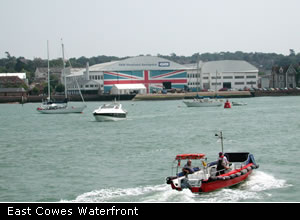East Cowes
 East Cowes is separated from its sister town, Cowes,
by the River Medina. East Cowes is best know for its industrial heritage and
for the fact that Queen Victoria lived at Osborne House which is a short distance
from the centre of the town. The town is familiar to visitors to the Island
as the terminal for the Southampton car ferry.
East Cowes is separated from its sister town, Cowes,
by the River Medina. East Cowes is best know for its industrial heritage and
for the fact that Queen Victoria lived at Osborne House which is a short distance
from the centre of the town. The town is familiar to visitors to the Island
as the terminal for the Southampton car ferry.
The town's industrial heritage is dominated by J.S.White's shipyard which was originally founded in 1881. Until its closure in 1966 the company built motor torpedo boats, destroyers and submarines mainly for the Royal Navy. Upon its closure the shipyard was taken over by the British Hovercraft Corporation (BHC). At the former White's site hundreds of Hovercraft, invented by Sir Christopher Cockerell in 1959, were developed and manufactured until the early 1980s. Another giant of British industrial history, Saunders Roe, built the famous Columbine Shed in East Cowes in 1935. The company built many sea planes including the largest ever metal seaplane The Princess. The Columbine shed is today owned by GKN Aerospace Services which painted a giant Union Jack on the door in 1977 in order to celebrate the Silver Jubilee of Queen Elizabeth II.
See also:
|
|||||||||||||||||||||||||||
The chain ferry floating bridge is one of only a handful of such operational vessels in the UK. The bridge is the only direct link between East Cowes and Cowes (which saves a drive to Newport) and has been run by the Isle of Wight Council since 1901. The first steam driven floating bridge was introduced in 1859.
Osborne House was designed by Prince Albert, the Queen's Consort, and built by Thomas Cubitt in 1845-48 as a retreat and family residence for Queen Victoria. Osborne House was the Queen's favourite residence after the death of Prince Albert in 1861 and she died at the House in 1901. Osborne House, with its two large towers and balconies reflected Prince Albert's interest in the Italian architecture of the period. The House was opened to the public in 1904 after Edward VII donated it to the nation. The State and private apartments used by Queen Victoria are open to the public as are the newly restored gardens which were opened to the public in 2000. From the House a path leads for half a mile to the Swiss Cottage which can also be reached by a free pony and trap service. The Swiss Cottage, a playhouse for the Royal children, was built by estate carpenters in the style of a Swiss chalet in 1854. Further details about Osborne House are available from English Heritage.
Norris Castle was designed in the Norman style by James Wyatt in the late eighteenth century. The building remains a private home. In 1798, the architect John Nash, began building work on his own future home, East Cowes Castle, where he later entertained the Prince regent and other prominent guests of the era. East Cowes Castle was notable for its Gothic towers and turrets and its elaborate castellation. Nash died in 1835 and was buried in the tower of East Cowes Church which he also designed. Regrettably the Castle designed by Nash was demolished during the 1960s, although the Ice House remains.
East Cowes marina has been enlarged and improved by its present owners, Dean and Reddyhoff, since 1998. The capacity of the marina is now 150 visitor moorings. East Cowes is also the focus of new residential and industrial development under the auspices of the Project Cowes initiative.










